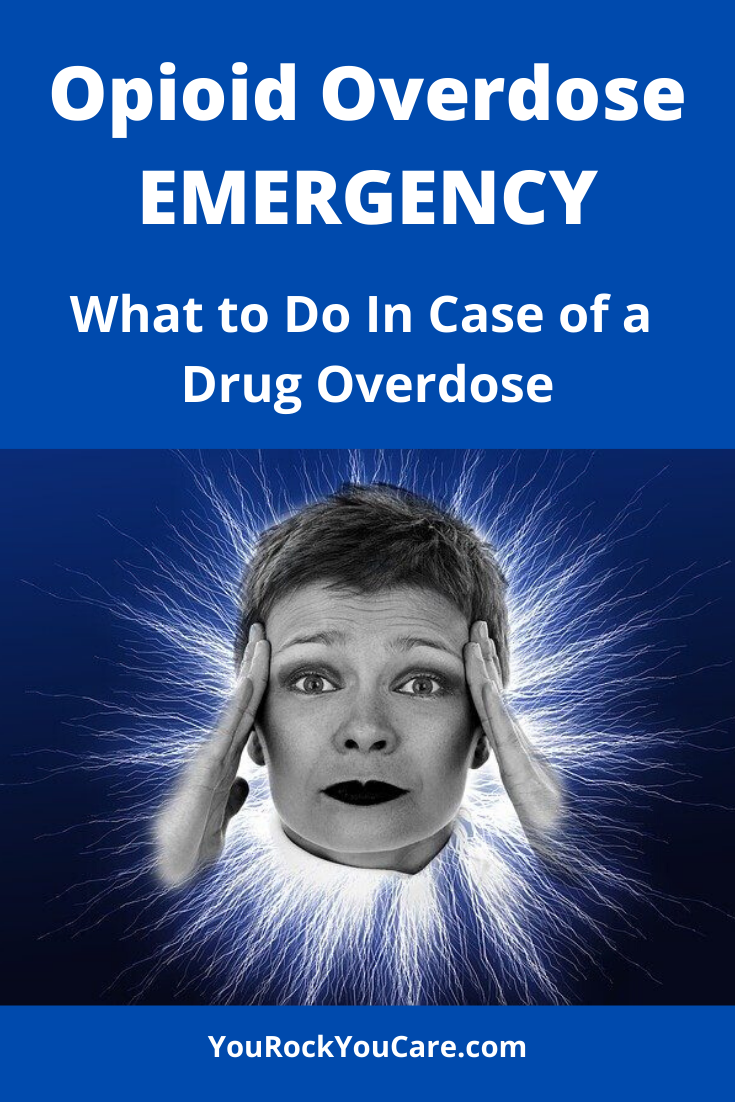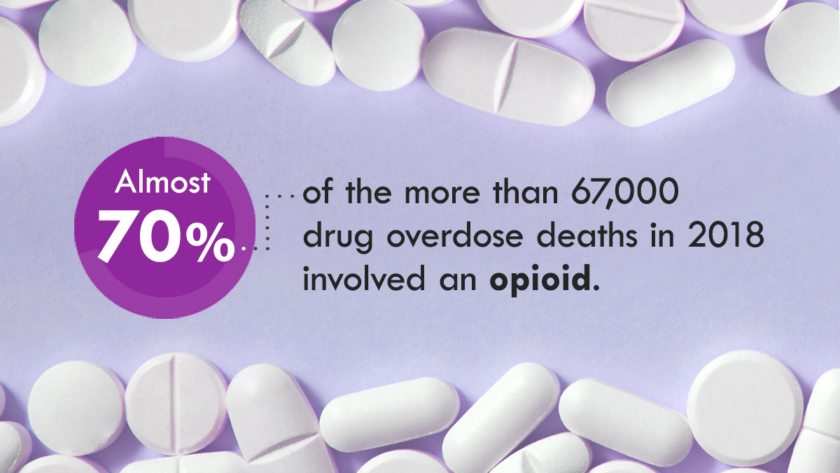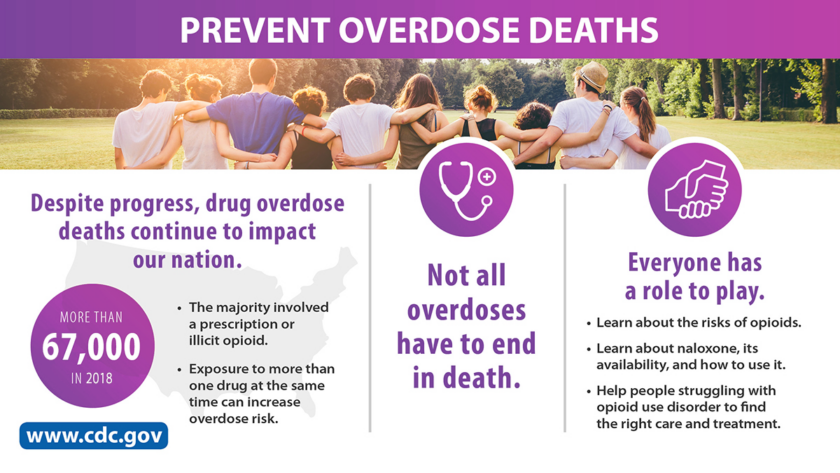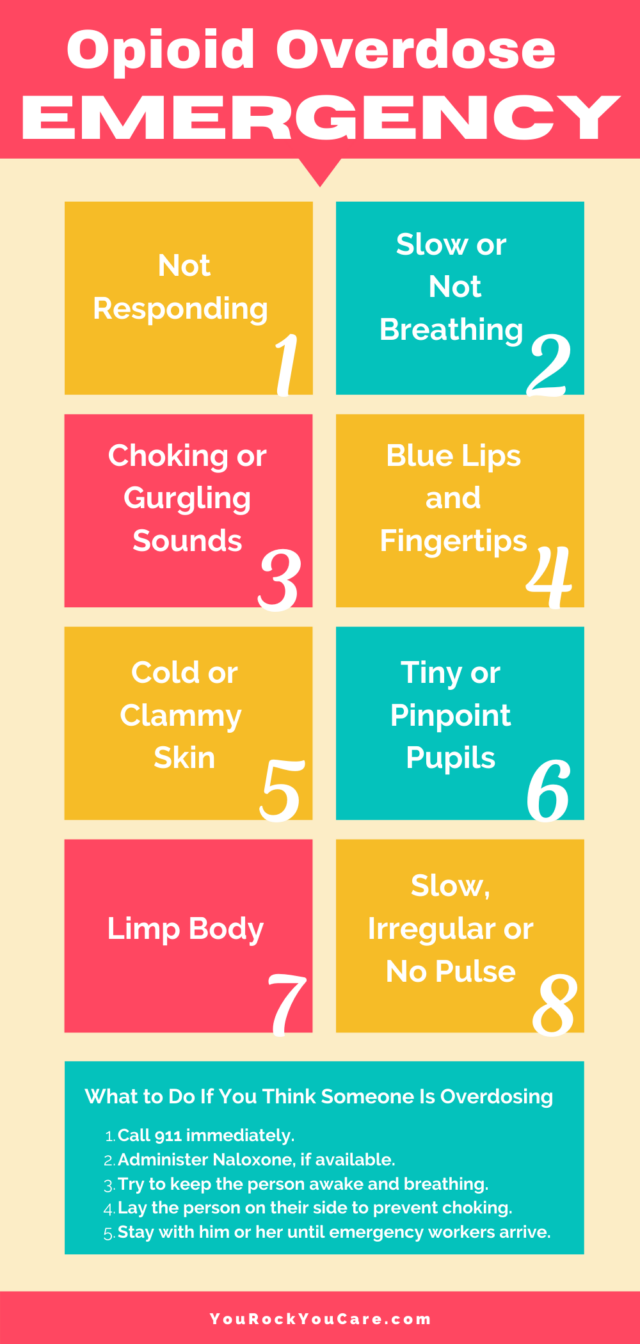A drug overdose doesn’t have to end in death…
By knowing the signs of opioid overdose and what to do, you can help save someone’s life. Read on…

Drug overdose can happen to anyone using, misusing or abusing any substance. It’s completely possible for someone to overdose the very first time they use a narcotic. However, an overdose doesn’t have to be deadly. Most people overdosing can be saved… if someone gets help for them and medical treatment is provided quickly enough.
Drug Overdose: What Most People Don’t Know… But Should
A drug overdose can happen when someone receives more substance or mixture of substances that his/her body can safely process. An overdose causes a high level of toxicity for an individual. So, it overwhelms their normal physiological functioning.
Symptoms of an overdose can vary depending on the substance taken. People can overdose on alcohol, illicit drugs, prescription medications and many other substances.
There’s no specific amount of any substance that will lead to overdose. It depends on the substance taken as well as the individual’s tolerance for it and other factors.
Anyone can overdose the very first time they use a drug of any substance.
Some people overdose intentionally to commit suicide. But, most drug overdoses are accidental.
Whether it’s intentional or accidental, overdoses are fatal in many cases. However, most people can be saved from a drug overdose, if medical treatment is provided quickly enough.
Any drug overdose is a medical emergency.
The problem is that most people under the influence of a substance may not realize that they’re experiencing an overdose. So, they don’t get help for themselves… until it’s too late. They depend on other people to help them get prompt medical attention and avoid death.
Many states have passed Good Samaritan laws. They legally protect the person who suffered the overdose as well as other people getting medical help for him/her from drug possession charges.
Global Drug Abuse and Drug Overdose Statistics
According to the World Health Organization, there are 31 million people worldwide that have drug use disorder. Drug abuse and deaths related to drug overdose are problems worldwide. According to the National Center for Drug Abuse Statistics (NCDAS):
- Every year, over 750,000 deaths worldwide are related to illegal drug use.
- Every year, over 170,000 deaths worldwide are due to drug overdoses.
- Opioids are the biggest cause of drug overdose deaths worldwide; 55% of drug abuse disorders are related to opioids.
Substance Abuse and Drug Overdose In the United States
According to the National Center for Drug Abuse Statistics (NCDAS), 20.3 million people in the US age 12 or older had a substance abuse disorder in 2018; this includes people abusing multiple substances as well as those with alcohol, opioid or illegal drug disorder:
- 8 million people had an alcohol use disorder
- 1 million people had an illegal drug disorder. Marijuana, which is legal in some states, was the most commonly abused drug; 4.4 million people had marijuana use disorder.
- 2 million people had an opioid disorder; this includes people abusing pain relievers and/or heroin.
According to the Centers for Disease Control and Prevention (CDC), there were 70,237 drug overdose deaths in the US in 2017 and 68% were opioid-related:
- 24,666 drug overdose deaths were Fentanyl-related
- 17,079 drug overdose deaths were prescription-opioid-related
- 15,482 drug abuse deaths were heroin-related
According to the National Institute on Drug Abuse:
- Opiates painkillers were prescribed 190 million times in 2017.
- Between 26-36 million people worldwide abuse opiates.
- Over 2 million adults in the US abuse opiate painkillers
- Nearly 500,000 adults in the US are addicted to heroin.
- About 75% of all people with opioid addiction disorder end up switching to heroin as a cheaper source of opioids.

All opioids have the potential for addiction and overdose. Opioids are the biggest cause of drug overdose deaths worldwide. Prescription opioids (like Morphine, Oxycodone and Hydrocodone) and illicit opioids (like heroin and Fentanyl made illegally) are powerful narcotics that have a high risk of potentially deadly overdose. Drug overdose can happen to anyone using, misusing or abusing any substance. It’s completely possible for someone to overdose the very first time they use a narcotic.
Opioid Overdose, Addiction and Abuse
The United States is in the midst of an opioid epidemic. Opioid overdose, addiction and abuse are causing serious health crisis worldwide as well as in the US.
Opioids are the biggest cause of drug overdose deaths worldwide.
Why?
An opioid overdose can happen quickly and easily.
The human body has opioid receptors widely distributed in the brain and spinal cord (central nervous system); they’re also distributed in the nerves that branch out from the brain and spinal cord to the muscles, organs and other parts of the body (peripheral nervous system).
Opioids work by binding to these receptors and blocking the perception of pain. They mimic the effects of pain-relieving chemicals that are produced naturally.
When too potent or too much opioid is ingested, it can easily overwhelm the opioid receptors all over the body.
An overdose happens when the brain is overwhelmed by the opioid taken and the body’s natural drive to breath is interrupted.
During an opioid overdose, breathing can be dangerously slowed or stopped. Lack of oxygen causes brain damage or death.
The speed of opioid overdose depends on the type of drug taken as well as the amount and other factors.
It can take an individual a few minutes to feel the effects of a heroin overdose. In contrast, a Fentanyl overdose can happen within seconds.
Understanding Opioids, Opiates and Narcotic Drugs
The term narcotics used to refer to mind-altering substances with euphoric and sleep-inducing effects. The Drug Enforcement Administration (DEA) now defines narcotic drugs as medications that relieve pain and dull the senses. They’re most commonly associated with opioids and opiates.
The term opiate refers to any drug derived from the naturally occurring opium alkaloids from the poppy plant.
Examples of opiates:
- Opium
- Codeine
- Morphine (Astramorph, Avinza, Kadian, MS Contin, Oramorph SR)
The term opioid refers to any drug that binds to opioid receptors and produces effects similar to opiates. Opioids can be natural opiates, synthetic (made completely in the lab) and semi-synthetic (created in the lab from naturally occurring opiates).
Opioids are considered to be narcotic drugs, which include both legally prescribed and illicit drugs.
Examples of opioids
- Carfentanil or Carfentanyl (Wildnil)
- Fentanyl (Actiq, Duragesic, Sublimaze and Fentora)
- Heroin
- Hydrocodone (Zohydro ER, and Hysingla ER)
- Hydrocodone with Acetaminophen (Lorcet, Lortab, Norco and Vicodin)
- Hydromorphone (Dilaudid and Exalgo)
- Levorphanol (Levo-Dromoran)
- Meperidine (Demerol)
- Methadone (Dolophine and Methadose)
- Oxycodone (OxyContin, OxyFast and Roxicodone)
- Oxycodone with Acetaminophen (Roxicet, Endocet and Percocet)
- Oxycodone and naloxone (Targiniq ER)
- Oxymorphone (Opana)
- Tapentadol (Nucynta and Nucynta ER)
- Tramadol (Ultram and ConZip)

The United States is in the midst of an opioid epidemic. Opioid overdose, addiction and abuse are causing serious health crisis worldwide as well as in the US. Using any drug or substance always carries the risk of serious side effects It doesn’t matter if you use alcohol, cocaine, opioid painkillers and other medications prescribed by a doctor… you’re at risk of addiction and overdose.
Opioid Overdose, Abuse and Addiction: What You Need to Know
In addition to pain relief, opioids also produce rewarding and euphoric effects. So, they’re highly addictive and targets for abuse.
Opioids are very effective in relieving pain, but people eventually develop a tolerance for them. So, they need higher doses of opioids to achieve the same pain relief as their body develops tolerance and becomes accustomed to it.
As their tolerance for opioids increases, people start taking increasingly higher doses to experience the same pain-relieving effects. Unfortunately, this also increases their risk of having an opioid overdose.
Although opiates are derived from naturally occurring substances, this doesn’t make them safer than opioids.
All opiates are opioids.
Regardless of type – whether they’re natural opiates, synthetic (made completely in the lab) or semi-synthetic (created in the lab from naturally occurring opiates) — ALL opioids have the potential for addiction and overdose.
Fentanyl and Carfentanyl Pose a Greater Risk of Opioid Overdose and Death Than Other Narcotics
- Fentanyl is a synthetic opioid approved by the US Food and Drug Administration (FDA) as an anesthetic and pain relief. It is one of the most abused narcotics today.
- Fentanyl is nearly 50-100 times more potent as heroin.
- It is increasingly combined with other drugs, including cocaine, meth and heroin.
- Fentanyl is estimated to be 50–100 times stronger than Morphine.
- About 2–3 milligrams of Fentanyl can be lethal. That’s roughly the size of 5–7 grains of salt.
- Carfentanil or Carfentanyl is the most potent Fentanyl analog in the US, causing the largest number of overdose deaths.
- It is 100 times stronger than Fentanyl and 10,000 times stronger than Morphine.
- As little as 0.00002 gram can kill a person.
- The drug is so powerful it’s also used to tranquilize elephants and other large mammals.
- It poses a significant threat to emergency responders and law enforcement personnel who touch it by accident. People exposed to Carfentanil can experience dizziness, shallow breathing, heart failure, clammy skin and more.
- People can overdose on Carfentanil rapidly.
- Naloxone can reverse the symptoms of overdose in a matter minutes for most opioids. But, multiple doses of Narcan may not be effective for Carfentanyl.
According to the CDC, 6 out of 10 drug overdoses were related to opioid use. Drug overdose has become the leading cause of death for individuals under the age of 50.
The average life expectancy in the United States decreased between 2015 and 2017 due to opioid overdose deaths.
6 Factors Which Can Increase the Risk of Opioid Overdose and Death
Anyone who uses opioids can experience overdose, but these factors can increase the risk (according to Centers for Disease Control and Prevention):
- Combining opioids with alcohol and/or other drugs
- Taking high dosages every day of prescription opoids
- Taking more opioids than prescribed
- Taking illegal opioids, such as heroin or illegally-made Fentanyl; they can contain extremely potent Carfentanyl or other harmful substances.
- Certain medical conditions, such as, sleep apnea, reduced kidney function, reduced liver function
- Age older than 65 years old
Signs and Symptoms of Opioid Overdose
Any drug overdose is a medical emergency.
When a person is overdosing, his or her breathing may be dangerously slowed or stopped. Without getting emergency help, (s)he can end up getting brain damage or dying due to lack of oxygen. So, you need to act fast when you recognize the signs and symptoms that someone is overdosing:
- Person is not responding to any stimulation
- Breathing is slow, shallow irregular or not breathing
- Choking or gurgling sounds
- Blue lips and fingertips
- Cold or clammy skin
- Tiny or small, constricted “pinpoint pupils”
- Limp body
- Slow, irregular heartbeat or no pulse
What You Need to Do, If Someone Is Overdosing On Opioids
Most people under the influence of a substance may not realize that they’re experiencing an overdose. So, they usually don’t get help for themselves… until it’s too late. They need help from other people to get prompt medical attention for them in order to avoid avoid death.
It may be hard to tell if someone is experiencing an overdose or just high. When in doubt, just call 911. You could save a life.
What you need to do if you think someone is overdosing:
- Call 911 immediately. If you’re not in the United States, call the emergency number for your country immediately.
- Give the anti-overdose drug, Naloxone (Narcan), if available.
- Try to keep the person overdosing on their side to prevent choking.
- Stay with him or her until emergency workers arrive.

Any drug overdose is a medical emergency. When a person is overdosing on opioids, his or her breathing may be dangerously slowed or stopped. Without getting emergency help, (s)he can end up getting brain damage or dying… due to lack of oxygen. Even if you’re not sure that someone is really overdosing, just call 911. You could save a life.
Preventing Drug Overdose
Using any drug or substance always carries the risk of serious side effects It doesn’t matter if you use alcohol, cocaine, opioid painkillers and other medications prescribed by a doctor… you’re at risk of addiction and overdose.
Drug overdose can happen to anyone using, misusing or abusing any substance. It’s completely possible for someone to overdose the very first time they use a narcotic.
Prescription opioids (like Morphine, Oxycodone and Hydrocodone) and illicit opioids (like heroin and Fentanyl made illegally) are powerful narcotics that have a high risk of potentially deadly overdose.
Did you know?
Someone dies from an opioid overdose in the US every 12.5 minutes.
About 83% of opioid-related deaths are accidental.
The best way to avoid dying from an overdose is to stop misusing or abusing opioids and other harmful substances.
By getting help from an addiction or substance abuse specialist, you can increase your chances of successful recovery. This can dramatically increase your chances of staying alive.
- You can get a treatment plan customized to your situation.
- You can get medications to reduce withdrawal symptoms and drug craving.
- Your health insurance may cover 100% of your treatment costs.
The Substance Abuse and Mental Health Services Administration is a branch of the U.S. Department of Health and Human Services. To find a substance abuse treatment specialist near you, click here.
